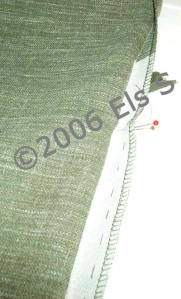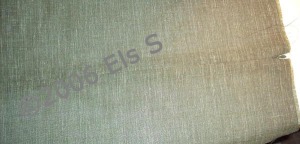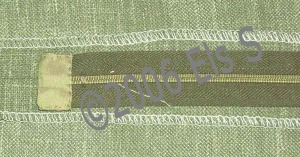by Diva Phyllis

Boy, it feels good to finish a UFO! Divas Ann and Georgene should recognize this jacket – I started it around the time the three of us went to the Chanel exhibit at the Met in the spring of 2005.
In my Chanel technique research, several authors mention the “poverty de luxe” and the “luxe cache” of Chanel haute couture – basically, the hidden luxury. I had no clue what that meant until I wore this jacket for the first time yesterday. It has a soft sweater like quality, and it’s sooo comfortable! In fact, I don’t store on a hanger – it’s folded up with my sweaters.
Chanel jackets have this special feature because their construction is not at all like traditional jacket sewing. In a regular, completely machine-sewn jacket, essentially two garments, lining and jacket, are constructed separately and sewn together. Chanel jackets are constructed as a single unit from the inside out, and each seam is enclosed in a logical manner out to the jacket edges, which are done last. So what does all of this hand sewing achieve? You get a jacket that feels like a sweater; soft, comfortable and pliable.
Commonly, in Chanel jackets, there are none of the facings, interfacings, or layers of pad stitched hair canvas commonly used in bespoke and couture tailoring. Rather, you create the jacket from the inside out with just fabric and lining. The jacket lining is quilted directly to the fashion fabric as the first stage of construction.
First, you create blocks of fabric and lining with the wrong sides basted together. The block is thread traced again to outlines the shape of the pattern piece (no seam allowance.) The lining is then quilted to the fabric. The bodice of this jacket is hand quilted, and the sleeves are machine quilted. I can’t remember why I decided to hand quilt the lining – maybe I thought the stitching would show to the front? Well, I ended up doing it by machine for the sleeves, and it’s not noticeable at all. Chanel jackets are machine quilted.
In the traditional Chanel method, each quilted jacket/lining piece is cut out as one. When the seams are sewn, the lining is folded back, the fashion fabric seams are machine stitched and then the lining seams are closed with hand fell stitches. The princess seams were sewn this way.
This photo shows the inside of the jacket at this stage. The quilted lining has been folded back so I could machine stitch the vertical seams. Then the lining seams were folded back over and stitched closed by hand with a fell stitch.

For the side and shoulder seams I decided to treat the two fabric layers as one, and according to my research, Chanel also did this occasionally. The princess seam edges were catch stitched down and then covered on the inside of the jacket with a non-bias strip of lining fabric hand fell stitched in place, sort of like a Hong Kong finish.

Another distinctive Chanel construction feature involves the famous braided trim. In the traditional method, these are also attached before the edges of the jacket are closed. This assures that none of the machine stitching for the braid shows on the lining of the jacket. After the trim is attached the jacket edges are turned under and basted. The lining is then turned under and basted. Then the lining is hand fell stitched around the jacket edges, as you can see in this photo (the color is off due to the flash – the rest of thephotos show a truer color fabric color.) The pockets are done the same way.
I had to figure out a way to do the pockets myself because none of my sources had much detail about them. So I adapted Cheri Dowd’s method used for the sleeves (details are below) The top edge of the pocket and lining are sewn, then I thread traced the pattern piece (no SA), fold the lining back down, and machine quilted it. Then I cut out the pocket and folded under the seam allowances and fell stitched the seams. Here are photos of a pocket partially complete:


You can also see the braid has been pulled apart. I’ve discovered this is a good way to reduce bulk. Just cut the chain stitching that holds the braid together, pull the pieces apart, stitch them together and trim the ends. This makes it easy to turn under the end of the braid. The braid on the jackets is done this way too, and the edges can just be butted together instead of lapping one end over the other.

This ended up being a UFO because, at the time I started this project, I found no information in my original sources as to how to construct and install the sleeves. Fortunately, Threads came to my rescue, and I used the sleeve method in Cheri Dowd’s article “Shortcuts to a Designer Jacket” in the new Dec‘06/Jan ’07 issue. A complete list of technque sources is on Pattern Review.
Cheri’s technique is ingenious and easy to understand, but I discovered what appear to be three omissions in the article: (1) for best results on a 2 piece sleeve, start quilting from the front underarm seam on the main sleeve piece to keep the quilting aligned with curve of the sleeve, (2) her article is silent on how to manage closing the 2nd underarm seam all the way to the sleeve edge – the quilted lining gets in the way. I ended up sewing the last few inches of this seam by hand, and the braid will cover this stitching. Lastly, (3) Cheri she doesn’t say whether she attaches the braid by machine or by hand, and also doesn’t state at what point in construction this should happen.
If you don’t want the braid stitching to show to the edge to edge lining them you have to sew on the trim as I did for the pockets, before you bag out the jacket. I didn’t realize this until it was too late for the sleeves, and so the braid stitching on the sleeves is sew on by hand because I didn’t want any stitching to show on the inside of the sleeve.
The final steps include attaching the pockets with hand fell stitches, and adding the distinctive curbed chain hem weight – which, incidentally, needs to taken out and sewn back in, by hand naturally, when the jacket is cleaned.

As my mother likes to say, “Sometimes we must sacrifice for fashion.”
Keep on Sewin’!
Phyllis












 I start sewing the zipper from the top down ( I sew the left side of the tape first) with a few back stitches and the last stitch is at the end of the opening I don’t back stitch here but I sew backwards.
I start sewing the zipper from the top down ( I sew the left side of the tape first) with a few back stitches and the last stitch is at the end of the opening I don’t back stitch here but I sew backwards. The next step is sewing the zipper from the top down ( I sew the left side of the tape first) with a few back stitches and the last stitch is at the end of the opening I don’t back stitch here but I sew backwards in a diagonal line for about 1 inch towards the outer edge of the zipper tape.
The next step is sewing the zipper from the top down ( I sew the left side of the tape first) with a few back stitches and the last stitch is at the end of the opening I don’t back stitch here but I sew backwards in a diagonal line for about 1 inch towards the outer edge of the zipper tape.













 Subscribe with Bloglines
Subscribe with Bloglines